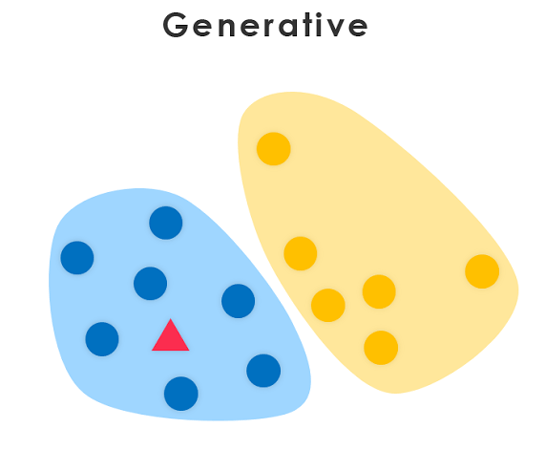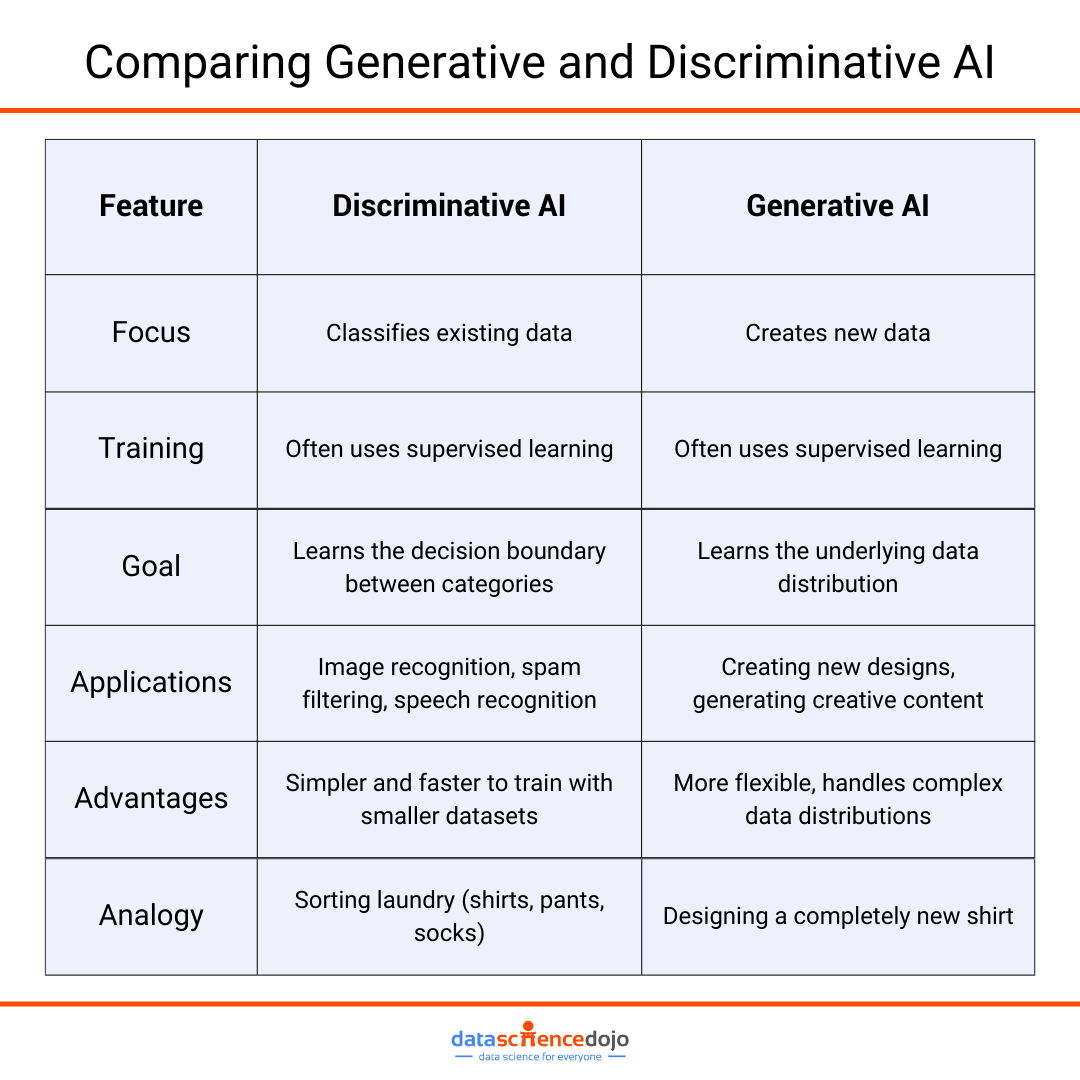In the recent discussion and advancements surrounding artificial intelligence, there’s a notable dialogue between discriminative and generative AI approaches. These methodologies represent distinct paradigms in AI, each with unique capabilities and applications.
Yet the crucial question arises: Which of these emerges as the foremost driving force in AI innovation? In this blog, we will explore the details of both approaches and navigate through their differences. We will also revisit some real-world applications of both approaches.
What is Generative AI?

Generative AI is a growing area in machine learning, involving algorithms that create new content on their own. These algorithms use existing data like text, images, and audio to generate content that looks like it comes from the real world.
This approach involves techniques where the machine learns from massive amounts of data. The process involves understanding how the data is structured, recognizing design patterns, and underlying relationships within the data.
Once the model is trained on the available data, it can generate new content based on the learned patterns. This approach promotes creativity and innovation in the content-generation process. Generative AI has extensive potential for growth and the generation of new ideas.
Explore the Impact of Generative AI on the future of work
Generative models that enable this AI approach to perform enable an in-depth understanding of the data they use to train. Some common generative models used within the realm of generative AI include:
- Bayesian Network – it allows for probabilistic reasoning over interconnected variables to calculate outcomes in various situations
- Autoregressive Models – they predict the next element in a sequence (like text or images) one by one, building on previous elements to create realistic continuations
- Generative Adversarial Network (GAN) – uses a deep learning approach with two models: a generator that creates new data and a discriminator that tests if the data is real or AI-generated
What is Discriminative AI?

Discriminative modeling, often linked with supervised learning, works on categorizing existing data. By spotting features in the data, discriminative models help classify the input into specific groups without looking deep into how the data is spread out.
Explore how Generative AI and LLMs empower non-profit organizations
Models that manage discriminative AI are also called conditional models. Some common models used are as follows:
- Logistic Regression – it classifies by predicting the probability of a data point belonging to a class instead of a continuous value
- Decision Trees – uses a tree structure to make predictions by following a series of branching decisions
- Support Vector Machines (SVMs) – create a clear decision boundary in high dimensions to separate data classes
- K-Nearest Neighbors (KNNs) – classifies data points by who their closest neighbors are in the feature space
Generative vs Discriminative AI: A Comparative Insight
While we have explored the basics of discriminative and generative AI, let’s look deeper into the approaches through a comparative lens. It is clear that both approaches process data in a different manner, resulting in varying outputs. Hence, each method has its own strengths and uses.

Generative AI is great for sparking creativity and new ideas, leading to progress in art, design, and finding new drugs. By understanding how data is set up, generative models can help make new discoveries possible.
Understand the Top 7 Generative AI courses offered online
On the other hand, discriminative AI is all about being accurate and fast, especially in sorting things into groups in various fields. Its knack for recognizing patterns comes in handy for practical ideas.
Generative AI often operates in unsupervised or semi-supervised learning settings, generating new data points based on patterns learned from existing data. This capability makes it well-suited for scenarios where labeled data is scarce or unavailable.
Learn Generative AI Roadmap
In contrast, discriminative AI primarily operates in supervised learning settings, leveraging labeled data to classify input into predefined categories. While this approach requires labeled data for training, it often yields superior performance in classification tasks due to its focus on learning discriminative features.
Hence, generative AI encourages exploration and creativity through the generation of new content and discriminative AI prioritizes practicality and accuracy in classification tasks.
Together, these complementary approaches form a symbiotic relationship that drives AI progress, opening new avenues for innovation and pushing the boundaries of technological advancement.
Real-World Applications of Generative and Discriminative AI
Let’s discuss the significant contributions of both generative and discriminative AI in driving innovation and solving complex problems across various domains.
Use Cases of Generative AI
A notable example is DeepMind’s AlphaFold, an AI system designed to predict protein folding, a crucial task in understanding the structure and function of proteins.
Released in 2020, AlphaFold leverages deep learning algorithms to accurately predict the 3D structure of proteins from their amino acid sequences, outperforming traditional methods by a significant margin. This breakthrough has profound implications for drug development, as understanding protein structures can aid in designing more effective therapeutics.
AlphaFold’s success in the recent Critical Assessment of Structure Prediction (CASP) competition, where it outperformed other methods, highlights the potential of generative AI in advancing scientific research and accelerating drug discovery processes.
Other use cases of generative AI include:
- Netflix – for personalized recommendations to boost user engagement and satisfaction
- Grammarly – for identifying errors, suggesting stylistic improvements, and analyzing overall effectiveness
- Adobe Creative Cloud – for concept generation, prototyping tools, and design refinement suggestions
Use Cases of Discriminative AI
Discriminative AI has found widespread application in natural language processing (NLP) and conversational AI. A prominent example is Google’s Duplex, a technology that enables AI assistants to make phone calls on behalf of users for tasks like scheduling appointments and reservations.
Duplex leverages sophisticated machine learning algorithms to understand natural language, navigate complex conversations, and perform tasks autonomously, mimicking human-like interactions seamlessly. Released in 2018, Duplex garnered attention for its ability to handle real-world scenarios, such as making restaurant reservations, with remarkable accuracy and naturalness.
Its discriminative AI capabilities allow it to analyze audio inputs, extract relevant information, and generate appropriate responses, showcasing the power of AI-driven conversational systems in enhancing user experiences and streamlining business operations.
Additional use cases of discriminative AI can be listed as:
- Amazon – analyzes customer behavior to recommend products of interest, boosting sales and satisfaction
- Facebook – combats spam and hate speech by identifying and removing harmful content from user feeds
- Tesla Autopilot – navigates roads, allowing its cars to identify objects and make driving decisions
Which is the Right Approach?
Discriminative and generative AI take opposite approaches to tackling classification problems. Generative models delve into the underlying structure of the data, learning its patterns and relationships. In contrast, discriminative models directly target the decision boundary, optimizing it for the best possible classification accuracy.
Understanding these strengths is crucial for choosing the right tool for the job. By leveraging the power of both discriminative and generative models, we can build more accurate and versatile machine-learning solutions, ultimately shaping the way we interact with technology and the world around us.






